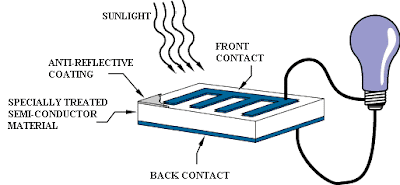Different Types of SolarEnergy Systems plus WindEnergy Systems
Many power plants today use fossil fuels as a heat source to boil water. The steam from the boiling water spins a large turbine, which drives a generator to produce electricity. However, a new generation of power plants with concentrating solar power systems uses the sun as a heat source. The three main types of concentrating solar power systems are: linear concentrator, dish/engine, and power tower systems.
Linear concentrator systems collect the sun's energy using long rectangular, curved (U-shaped) mirrors. The mirrors are tilted toward the sun, focusing sunlight on tubes (or receivers) that run the length of the mirrors. The reflected sunlight heats a fluid flowing through the tubes. The hot fluid then is used to boil water in a conventional steam-turbine generator to produce electricity. There are two major types of linear concentrator systems: parabolic trough systems, where receiver tubes are positioned along the focal line of each parabolic mirror; and linear Fresnel reflector systems, where one receiver tube is positioned above several mirrors to allow the mirrors greater mobility in tracking the sun.
A dish/engine system uses a mirrored dish similar to a very large satellite dish. The dish-shaped surface directs and concentrates sunlight onto a thermal receiver, which absorbs and collects the heat and transfers it to the engine generator. The most common type of heat engine used today in dish/engine systems is the Stirling engine. This system uses the fluid heated by the receiver to move pistons and create mechanical power. The mechanical power is then used to run a generator or alternator to produce electricity.
A power tower system uses a large field of flat, sun-tracking mirrors known as heliostats to focus and concentrate sunlight onto a receiver on the top of a tower. A heat-transfer fluid heated in the receiver is used to generate steam, which, in turn, is used in a conventional turbine generator to produce electricity. Some power towers use water/steam as the heat-transfer fluid. Other advanced designs are experimenting with molten nitrate salt because of its superior heat-transfer and energy-storage capabilities. The energy-storage capability, or thermal storage, allows the system to continue to dispatch electricity during cloudy weather or at night.
You can build your own SolarEnergy "Photovoltaic Cell" System at home and even sell the power you make, if you build your system is large enough, back to the power company.
Below you will find links to two sites which will provide you with the knowledge to build a solarenergy system in your own backyard, "Home Solar Energy"
They will also provide you with information on how to build a homemade wind turbine" to supplement the solarenergy system. "Home Wind Power" using an "homemade wind turbine" or wind powered generator is another project you can complete at home using the instruction from the links below.
"Wind Turbine Design" for residential windpower is just one more way these links will sve you money on you "energy billing".
Check this out today and build your system in as quick as a weekend and they add to it over the course of the coming weeks and months.
You can build your own SolarEnergy "Photovoltaic Cell" System at home and even sell the power you make, if you build your system is large enough, back to the power company.
Below you will find links to two sites which will provide you with the knowledge to build a solarenergy system in your own backyard, "Home Solar Energy"
They will also provide you with information on how to build a homemade wind turbine" to supplement the solarenergy system. "Home Wind Power" using an "homemade wind turbine" or wind powered generator is another project you can complete at home using the instruction from the links below.
"Wind Turbine Design" for residential windpower is just one more way these links will sve you money on you "energy billing".
Check this out today and build your system in as quick as a weekend and they add to it over the course of the coming weeks and months.
CLICK BELOW AND SAVE $$ TODAY







